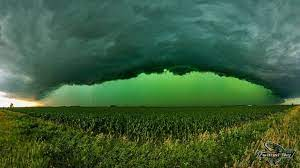Important Facts For Prelims
Derecho
- 08 Jul 2022
- 3 min read
Why in News?
Recently, a few States of US were hit by a storm system called a Derecho, turning Sky Green.
- They mostly occur across central and eastern parts of the United States. In 2009 “Super Derecho” was one of the “most intense and unusual derechos ever observed” in the US as it swept from Kansas to Kentucky (US States) with wind speeds reaching up to 170 km/hr.
- In 2010, Russia witnessed its first documented derecho. They have also swept through Germany and Finland, and more recently in Bulgaria and Poland.

What is Derecho?
- About:
- A Derecho is “a widespread, long-lived, straight-line windstorm” that is associated with a “band of rapidly moving showers or thunderstorms”.
- The name comes from the Spanish word ‘la derecha’ which means ‘straight’.
- Straight-line storms are those in which thunderstorm winds have no rotation unlike a tornado. These storms travel hundreds of miles and cover a vast area.
- It is a warm-weather phenomenon that generally occurs in June and July.
- They are a rare occurrence as compared to other storm systems like tornadoes or hurricanes.
- A Derecho is “a widespread, long-lived, straight-line windstorm” that is associated with a “band of rapidly moving showers or thunderstorms”.
- Types:
- Progressive:
- A progressive derecho is associated with a short line of thunderstorms that may travel for hundreds of miles along a relatively narrow path.
- It is a summer phenomenon.
- Serial:
- A serial derecho, on the other hand, has an extensive squall line – wide and long – sweeping across a large area.
- It usually occurs during spring or fall.
- Hybrid:
- Hybrid ones have the features of both progressive and serial derechos.
- Progressive:
What Makes Sky Green Amid Derecho?
- Severe thunderstorms result in a ‘green sky’ due to light interacting with the huge amount of water they hold.
- The big raindrops and hail scatter away all but the blue wavelengths due to which primarily blue light penetrates below the storm cloud.
- This blue then combines with the red-yellow of the afternoon or the evening sun to produce green.




